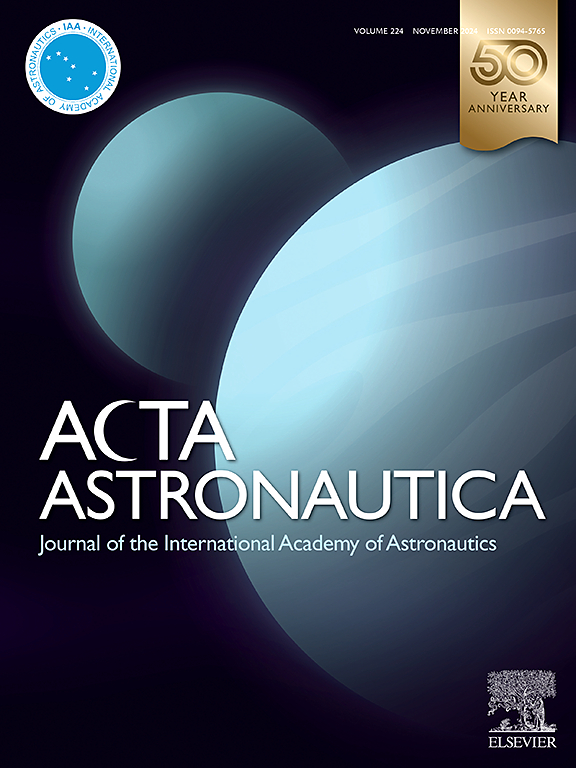具有仿生轮面和轮耳的新型网状轮的研究,以提高月球车的性能
IF 3.1
2区 物理与天体物理
Q1 ENGINEERING, AEROSPACE
引用次数: 0
摘要
随着月球探测的深入,无人月球车工作环境更加恶劣多变,工作条件日益复杂,探测范围要求不断提高。现有的无人月球网轮已不能满足未来月球任务对牵引性能、可靠性和功耗的要求。本研究以鸵鸟脚趾的功能特点为灵感,设计了仿生轮和对比轮。通过交换轮面和轮耳(grousers),开发并测试了四种类型的网格轮(wheel 1-4)。采用不同的载荷和滑移比,研究了网轮的表面形状及其轮缘形状对牵引性能的影响以及对整体牵引性能的增强。试验结果表明,1号轮在特定工况下的牵引性能优于其他轮,且在较低滑移比下表现出更高的能效。这使得仿生车轮表面下的压实颗粒产生横向正向反作用力,从而推动车轮。这使得仿生车轮表面下的压实颗粒产生横向向前反作用力,从而推动车轮向前。仿生耳的工作原理与此类似;然而,它们对牵引力的贡献不如仿生车轮表面的贡献显著。轮面和轮耳的创新设计有效地解决了现有月球网轮结构的局限性。本文章由计算机程序翻译,如有差异,请以英文原文为准。
Research in innovative mesh wheel with bionic wheel surfaces and lugs for superior lunar rover performance
As lunar exploration progressed, unmanned lunar rovers encountered harsher and more variable working environments, increasingly complex operating conditions, and greater exploration range requirements. Existing unmanned lunar mesh wheels could not meet the demands of future lunar missions, which required higher traction performance, greater reliability, and lower power consumption. In this study, inspired by the functional characteristics of ostrich toes, we designed a bionic wheel and a comparison wheel. By interchanging the wheel surfaces and lugs (grousers), four types of mesh wheels (Wheels 1–4) were developed and tested. Various loads and slip ratios were applied to investigate how the surface shape of the mesh wheel and the shape of its lugs influenced traction performance and enhanced overall traction. The test results indicated that Wheel 1 outperformed the other wheels in terms of traction performance under the specified conditions and demonstrated greater energy efficiency at lower slip ratios. This led the compacted particles beneath the bionic wheel surface to generate a lateral forward reaction force, thereby propelling the wheel. This caused the compacted particles beneath the bionic wheel surface to generate a lateral forward reaction force, thereby propelling the wheel forward. The bionic lugs operated on a similar principle; however, their contribution to traction was less significant than that of the bionic wheel surface. The innovative design of the wheel surface and lugs effectively addressed the limitations of existing lunar mesh wheel structures.
求助全文
通过发布文献求助,成功后即可免费获取论文全文。
去求助
来源期刊

Acta Astronautica
工程技术-工程:宇航
CiteScore
7.20
自引率
22.90%
发文量
599
审稿时长
53 days
期刊介绍:
Acta Astronautica is sponsored by the International Academy of Astronautics. Content is based on original contributions in all fields of basic, engineering, life and social space sciences and of space technology related to:
The peaceful scientific exploration of space,
Its exploitation for human welfare and progress,
Conception, design, development and operation of space-borne and Earth-based systems,
In addition to regular issues, the journal publishes selected proceedings of the annual International Astronautical Congress (IAC), transactions of the IAA and special issues on topics of current interest, such as microgravity, space station technology, geostationary orbits, and space economics. Other subject areas include satellite technology, space transportation and communications, space energy, power and propulsion, astrodynamics, extraterrestrial intelligence and Earth observations.
 求助内容:
求助内容: 应助结果提醒方式:
应助结果提醒方式:


